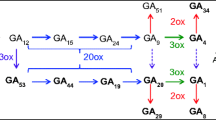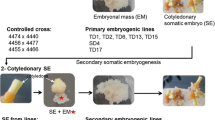Abstract.
Following loblolly pine (Pinus taeda L.) seed germination, storage-protein breakdown in the megagametophyte and in the seedling results in a large increase in the seedling's free amino acid pool. A substantial portion of both the storage proteins and the amino acid pool is arginine, a very efficient nitrogen-storage compound. Free arginine is hydrolyzed in the seedling by the enzyme arginase (EC 3.5.3.1), which is under strong developmental control. At present, regulation of arginase in conifers is not well understood. Here we report the utilization of an in vitro culture system to address the separate impacts of the seedling and megagametophyte tissues on arginase enzyme activity, protein levels and patterns of gene expression. We also describe the generation of an anti-arginase antibody prepared from a histidine-tagged loblolly pine arginase fusion protein expressed in Escherichia coli. Our results indicate that arginase gene expression in the seedling is initiated by the seedling itself and then maintained or up-regulated by the megagametophyte. The contribution of storage-protein breakdown and the free amino acid pool, particularly arginine, in this regulation is also addressed.
Similar content being viewed by others
Author information
Authors and Affiliations
Additional information
Electronic Publication
Rights and permissions
About this article
Cite this article
Todd, C.D., Gifford, D.J. The role of the megagametophyte in maintaining loblolly pine (Pinus taeda L.) seedling arginase gene expression in vitro. Planta 215, 110–118 (2002). https://doi.org/10.1007/s00425-001-0720-2
Received:
Accepted:
Issue Date:
DOI: https://doi.org/10.1007/s00425-001-0720-2




